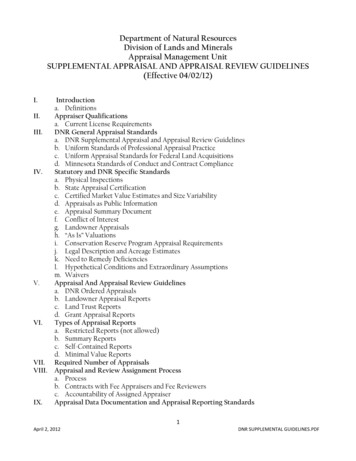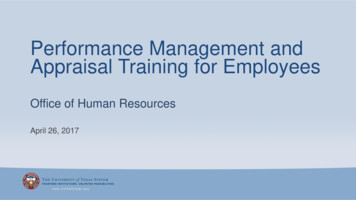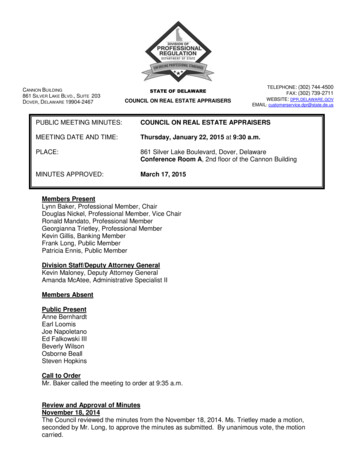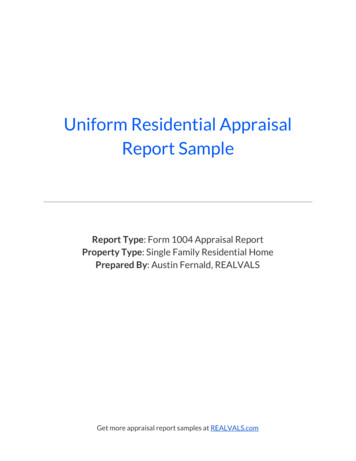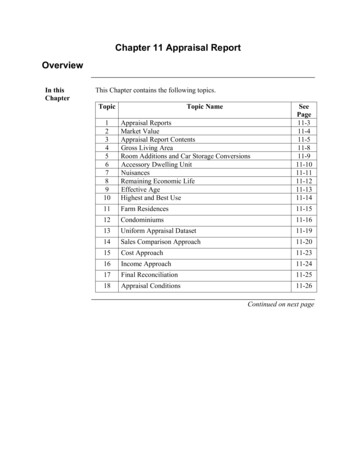
Transcription
Chapter 11 Appraisal ReportOverviewIn thisChapterThis Chapter contains the following topics.TopicTopic Name12345678910Appraisal ReportsMarket ValueAppraisal Report ContentsGross Living AreaRoom Additions and Car Storage ConversionsAccessory Dwelling UnitNuisancesRemaining Economic LifeEffective AgeHighest and Best 11-1411Farm Residences11-1512Condominiums11-1613Uniform Appraisal Dataset11-1914Sales Comparison Approach11-2015Cost Approach11-2316Income Approach11-2417Final Reconciliation11-2518Appraisal Conditions11-26Continued on next page
VA Pamphlet 26-7, RevisedChapter 11: Appraisal ReportOverview, continueda. In thisChapter,continuedTopic1920212211-2Topic NameAppraiser Training a New AppraiserLiquidation AppraisalsPartial Release AppraisalsVacant Land AppraisalsSeePage11-2711-2811-3111-33
VA Pamphlet 26-7, RevisedChapter 11: Appraisal Report1. Appraisal ReportsChange DateFebruary 22, 2019 This Chapter has been revised in its entirety.a. USPAP andVARequirementsThe appraiser assigned by VA must prepare the appraisal report in accordancewith Uniform Standards of Professional Appraisal Practice (USPAP), thespecific VA requirements outlined in this handbook, and in circularsperiodically issued when program changes arise.b. AppraisersTrained by VAAppraisers who have been appointed to VA’s fee appraiser panel have beentrained on VA appraisal requirements. Lenders may rely on VA fee panelappraisers to have performed the appraisal in accordance with VA guidelineswithout the need for additional statements or certifications.c. SARResponsibilitiesLenders’ Staff Appraisal Reviewers (SARs) who are reviewing appraisalreports must be familiar with residential appraisal principles and VA’sspecific requirements for appraisal reports.11-3
VA Pamphlet 26-7, RevisedChapter 11: Appraisal Report2. Market ValueChange DateFebruary 22, 2019 This Chapter has been revised in its entirety.a. MarketValueDefinitionThe appraiser must estimate the market value, as "the most probable price thata property should bring in a competitive and open market under all conditionsrequisite to a fair sale, the buyer and seller, each acting prudently,knowledgeably and assuming the price is not affected by undue stimulus.”VA considers reasonable value and market value to be synonymous. VA’sdefinition of market value is consistent with that used by Fannie Mae, FreddieMac, and major appraisal organizations.b. Protectingthe Interests ofVeterans,Lenders,Servicers andVAThe quality of the appraisal is critical in protecting the interests of Veterans,lenders, servicers, and VA. This fact requires VA to be integrally involved inits management and oversight of the appraisal process, from the initialassignment of the appraiser through the issuance of the Notice of Value(NOV), as well as oversight performed on closed loans.c. OversightAny appraisal report is unacceptable if the analysis is not based uponrecognized appraisal practices and was intended to "accommodate" or "meet"the sales price.11-4
VA Pamphlet 26-7, RevisedChapter 11: Appraisal Report3. Appraisal Report ContentsChange Datec. AppraisalReportContentsFebruary 22, 2019 This Chapter has been revised in its entirety.1. Invoice2. AppraisalForm3. StreetMapFor consistency, the first page of PDF file uploaded intoWebLGY Lender’s name and “Department of Veterans Affairs”must be provided in the Lender/Client field on theappraisal report form The VA assigned fee appraiser’s signature must beprovided in the signature block with the feeappraiser’s VA ID in the “other” block, just belowstate certification and license informationAppraisal forms accepted by VA Fannie Mae Form 1004, Uniform ResidentialAppraisal Report Fannie Mae Form 2055, Exterior-Only InspectionResidential Appraisal Report, for liquidationappraisals only if interior access was not provided Fannie Mae Form 1004C, Manufactured HomeAppraisal Report, Fannie Mae Form 1073, IndividualCondominium Unit Appraisal Report Fannie Mae Form 1075, Exterior-Only InspectionIndividual Condominium Unit Appraisal Report, forliquidation appraisals only if interior access was notprovided Fannie Mae Form 1025, Small Residential IncomeProperty Appraisal Report, Commercially available vacant land form, forliquidation appraisals if the improvements have nocontributory value (see Topic 22 of this Chapter.) Showing location of subject and each comparable sale Additional maps if sales are a substantial distanceaway from the subject.Continued on next page11-5
VA Pamphlet 26-7, RevisedChapter 11: Appraisal Report3. Appraisal Report Contents, continuedc. AppraisalReportContents,continued4. BuildingSketch 5.Photographs 6. Repair list7. UniformAppraisalDataset(UAD) Gross living area calculationsExterior dimensions of dwelling, basement, and anyother improvements contributing valueBasement may be shown in relation to the floor planof the house instead of separatelyFloor plan layout (interior room dimensions andpartitioning are not required)If interior access is not provided on a liquidationappraisal, a sketch is not requiredClear and labeledFront and rear taken at opposite angles to show allsides of the dwelling if possibleImprovements with contributory valueMinimum Property Requirement (MPR) repair itemsStreet sceneAny views affecting valueKitchenMain living areaBathroomsAny recent updates, remodeling or renovationFront view of each comparable sale (real estatemarketing photographs are acceptable with anexplanation, for example, to exhibit condition at thetime of sale, or if a comparable sale is in a gatedcommunity that was not accessible to the appraiser)For condominiums, if the subject and sales are in thesame building or identical buildings, the appraisermay comment instead of providing photographs of thesalesInterior photographs are not required on liquidationappraisals when access to the interior of the propertyis not availableItemized list of any observed MPR repairs (seeChapter 12 of this handbook) or customer preferenceitems to be installed on new construction appraisalsMay be included directly on the appraisal formUAD Property Condition and Quality RatingDefinitionsUAD Property Description Abbreviations (see Topic13 of this chapter)Continued on next page11-6
VA Pamphlet 26-7, RevisedChapter 11: Appraisal Report3. Appraisal Report Contents, continuedc. rtifications 9.Liquidationappraisaladdendum Required by state lawRelated to continuing education or membership inprofessional appraisal organizationsAdditional certifications may be made on a separateform or page, provided they do not conflict with thelanguage on the Statement of Assumptions andLimiting Conditions, any preprinted language on theappraisal form, or VA appraisal requirementsRequired on liquidation appraisals only (see Topic 20of this chapter)11-7
VA Pamphlet 26-7, RevisedChapter 11: Appraisal Report4. Gross Living AreaChange DateFebruary 22, 2019 This Chapter has been revised in its entirety.a. DefinitionGross living area (GLA) refers to the square footage of the area that isfinished, habitable, contiguous, above-grade, residential space calculated bymeasuring the outside walls of the structure.b. NonContiguousAreasThe functional utility and contributory value of any non-contiguous areasshould be considered by the appraiser and listed separately from the GLA onthe market data grid.c. BasementsBasements, whether or not finished, must not be included in the GLA.d. AtticsFinished attics may be included in the GLA.e. Below-GradeAreasIf any part of a finished level is below grade, the appraiser must determinewhether it should be considered GLA or valued separately.If the appraiser determines that a partially below-grade habitable space issimilar to the GLA in design, quality of construction, and appeal, has fullutility and is accepted in the market, the appraiser may include the area in theGLA.If the partially below-grade space is inferior to the rest of the property and notaccepted in the market, the appraiser may determine that the area is not part ofthe GLA. In cases such as these, the contributory value of partially belowgrade space should be considered separately on the market data grid.11-8
VA Pamphlet 26-7, RevisedChapter 11: Appraisal Report5. Room Additions and Car Storage ConversionsChange DateFebruary 22, 2019 This Chapter has been revised in its entirety.a. GLAConsiderationsRoom additions and enclosures of garages and carports into the living areashould be included in the GLA if the added space is: b. Non-GLAAreas ValuedSeparatelyaccessible from the interior of the main dwelling in a functionalmanner,has a permanent and sufficient heat source, andis similar in design, quality of construction and appeal to the maindwelling.Added space that does not meet the criteria listed above must be valuedseparately from the GLA on the market data grid. The appraiser mustconsider the effect on marketability of an inferior addition or conversion whenarriving at the line item adjustment for the added space. When selecting andanalyzing comparable sales, the appraiser should consider the differences inquality and utility of room additions and converted spaces when comparedwith originally constructed space.11-9
VA Pamphlet 26-7, RevisedChapter 11: Appraisal Report6. Accessory Dwelling UnitChange DateFebruary 22, 2019 This Chapter has been revised in its entirety.a. Single RealEstate EntityAn Accessory Dwelling Unit (ADU) is a living unit including kitchen,sleeping, and bathroom facilities added to or created within a single-familydwelling, or detached on the same site. A manufactured home on the sitecould be an ADU. The dwelling and the ADU together constitute a single realestate entity.b. Highest andBest UseAs part of the highest and best use analysis, the appraiser must determine ifthe property is a single-family dwelling with an ADU, or a two-familydwelling. The highest and best use must be a legal use (see Topic 10). Atwo-family dwelling must be appraised on the Fannie Mae Form 1025, SmallResidential Income Property Appraisal Report.c. ADU ValuedSeparatelyAn ADU is usually subordinate in size, location, and appearance to theprimary dwelling unit and may or may not have separately metered utilitiesand separate means of ingress and egress. The appraiser must not include theliving area of the ADU in the calculation of the GLA of the primary dwelling.The ADU must be valued separately as a line item on the market data grid.d. Notify theLender if Morethan One UnitThe appraiser must notify the lender if a property has more than one ADU.e. DetachedBuildingsA manufactured home, shed, or other detached building on the property whichdoes not have kitchen, sleeping, and bathroom facilities or cannot be legallyused as a dwelling, may be valued as storage space if it does not present anyhealth or safety issues.11-10
VA Pamphlet 26-7, RevisedChapter 11: Appraisal Report7. NuisancesChange DateFebruary 22, 2019 This Chapter has been revised in its entirety.a. Effect onValueWhile nuisances do not make a property ineligible or require repair, theappraiser must describe any nuisances and consider any effect on value.b. Sales withSame InfluenceIf available, comparable sales influenced by the same nuisance, should beused by the appraiser.c. ExamplesExamples of nuisances include heavy traffic, noise from a nearby highway, orodors from a factory in the vicinity.11-11
VA Pamphlet 26-7, RevisedChapter 11: Appraisal Report8. Remaining Economic LifeChange DateFebruary 22, 2019 This Chapter has been revised in its entirety.a. Factors inEstimatingRemainingEconomic LifeRemaining economic life is the estimated period of time until theimprovements are expected to no longer serve their intended purpose as ahome. In estimating the remaining economic life, the appraiser must consider: the relationship between the property and the economic stability of theblock, neighborhood, and community,comparisons with homes in the same or similar areas,the need for a home of the particular type being appraised,the architectural design, style and functional utility of the property,the condition and durability of the property,maintenance levels of other properties in the area, andin areas where municipalities have established code enforcement areas,their expected results in improving the neighborhood for residentialuse.b. Comment ifUnder 30 YearsThe appraiser must estimate the remaining economic life as a single numberand include specific comments if the estimated remaining economic life is lessthan 30 years.c. ReportingThe estimated remaining economic life must be provided in the cost approachsection of the appraisal report. For condominium units, the estimatedremaining economic life must be provided in the “Reconciliation” section ofthe appraisal report.11-12
VA Pamphlet 26-7, RevisedChapter 11: Appraisal Report9. Effective AgeChange DateFebruary 22, 2019 This Chapter has been revised in its entirety.a. EstimatingEffective AgeWhile the actual age is the number of years since the home was constructed,the effective age reflects the condition and functional utility of the property.For example, remodeling will likely decrease the effective age of a homewhile a lack of maintenance can increase the effective age, possibly to anumber greater than the actual age.b. Comment ifSignificantChange FromActual AgeThe appraiser must state the effective age as a single number and includecomments if the effective age differs significantly from the actual age.c. CompletedRepairsConsideredSince recommended repairs are included in value on origination appraisals,the effective age should reflect the condition of the property as repaired.11-13
VA Pamphlet 26-7, RevisedChapter 11: Appraisal Report10.Highest and Best UseChange DateFebruary 22, 2019 This Chapter has been revised in its entirety.a. DefinitionThe highest and best use of a property is the most probable use which isphysically possible, appropriately supported, legally permissible, financiallyfeasible, and results in the highest value.b. Appraisal toMeet VAGuidelinesWhile the appraiser must determine the highest and best use, the appraisermust also complete the appraisal in accordance with VA guidelines. Forexample, since VA-guaranteed loans are made for residential purposes, novalue may be given to commercial uses, crops, livestock, land for futuredevelopment, or any other non-residential use.11-14
VA Pamphlet 26-7, RevisedChapter 11: Appraisal Report11.Farm ResidencesChange DateFebruary 22, 2019 This Chapter has been revised in its entirety.a. FarmResidence is anEligiblePropertyAlthough VA does not make farm or other business loans, Veterans may usetheir VA home loan benefit to purchase a property on which there is a farmresidence.b. No Limit onNumber ofAcresVA does not set a limit on the number of acres which the property may have.The appraisal of properties with acreage should not present difficulties ifsimilar properties in the area were recently sold primarily for residential use.c. ResidentialPurposesConsidered inValuationImprovements not typically considered residential, for example, barns,corrals, or stables, must be valued by the appraiser as they contribute to themarket value of the property for residential purposes only. The appraiser mustnot include in value any livestock, crops, or farm equipment.11-15
VA Pamphlet 26-7, RevisedChapter 11: Appraisal Report12.CondominiumsChange DateFebruary 22, 2019 This Chapter has been revised in its entirety.a.CondominiumDevelopmentAccepted byVAAll condominium units, including site condominiums and manufactured homecondominiums, must be located in a condominium development that has beenaccepted by VA prior to loan guaranty. SARs receiving an appraisal for acondominium unit in a development that has not been at least conditionallyaccepted by VA may not issue the NOV.b. AvoidUnnecessaryAppraisal FeeEnsuring that the condominium is accepted by VA before ordering theappraisal is recommended to avoid an unnecessary appraisal fee in the eventthat the condominium is not accepted by VA.c. IneligibleProperty TypesCondo-hotel properties where units are placed in a rental pool and “air”condominiums that do not have a homeowners association are not eligible forappraisal as these condominiums do not meet VA guidelines. If a questionarises as to whether or not a condominium would be accepted by VA, VAacceptance should be requested (see subsection g of this Topic).d. HUD/FHAReview ProcessVA no longer accepts HUD/FHA condominium approvals as thecondominium approval requirements differ from VA’s requirements.e. SpotApprovalsVA does not perform “spot” approvals of individual condominium unitswithin a condominium development.f.CondominiumList AvailableOnlineA list of VA-accepted condominium developments, with any conditionsneeded for approval, and condominium ID numbers, may be found athttps://vip.vba.va.gov/portal/VBAH/Home under “Featured Items” in “CondoReports”.Continued on next page11-16
VA Pamphlet 26-7, RevisedChapter 11: Appraisal Report12. Condominiums, continuedg. DocumentsNeeded forReviewLenders seeking VA acceptance of a condominium which has not alreadybeen reviewed by VA must establish a record for the condominium inWebLGY and upload the following documents in PDF format in this stackingorder: h. Legal ReviewResultsDeclarationBylawsAmendmentsPlat MapRules and RegulationsMeeting MinutesBudgetSpecial Assessment LetterLitigation LetterPresale LetterAny additional documentsWhen the required documents are uploaded, the RLC will request a review byVA’s legal counsel. The RLC will notify the requester of the results of thereview and update the status of the condominium in WebLGY.Continued on next page11-17
VA Pamphlet 26-7, RevisedChapter 11: Appraisal Report12. Condominiums, continuedi. AppraisalRequirementsIn most cases, the appraiser will prepare the appraisal on Fannie Mae Form1073, Individual Condominium Unit Appraisal Report. Appraisals ofmanufactured home condominium units must be prepared on Fannie MaeForm 1004C, Manufactured Home Appraisal Report, with the details aboutthe condominium development usually provided in the Project InformationSection of the condominium appraisal form included within the appraisalreport. Liquidation appraisals of condominium units must be prepared onFannie Mae Form 1075, Exterior-Only Inspection Individual CondominiumUnit Appraisal Report, if interior access was not provided. In theCondominium Appraisal Report, the appraiser will: indicate which utilities are included in the monthlyhomeowners association fee,comment on the adequacy of the monthly assessment,based upon the appraiser’s opinion of the adequacy of theproject’s budget and a comparison to similarcondominium developments,recommend a fair assessment if the current assessment isconsidered inadequate, andreport any known pending litigation involving the subjectcondominium development or its homeownersassociation.j. Pre-saleRequirementFor new condominium developments, a pre-sale requirement of 70 percentmust be included on the NOV and satisfied prior to VA loan guaranty.k. WooddestroyingInsect ReportsA wood-destroying insect inspection is not required on units in low-rise orhigh-rise condominiums (units are stacked vertically), unless the appraisernotes a potential infestation problem. For site condominiums andvilla/townhome style condominiums where units are side by side, located in a“very heavy” or “moderate to heavy” zone, a wood-destroying insectinspection must be required on the NOV unless evidence of a treatmentguarantee has been provided by the homeowners association.11-18
VA Pamphlet 26-7, RevisedChapter 11: Appraisal Report13. Uniform Appraisal Dataset (UAD)Change DateFebruary 22, 2019 This Chapter has been revised in its entirety.a. DefinitionThe UAD improves the quality and consistency of appraisal data by definingall fields required on specific appraisal forms and standardizes definitions andresponses for a key subset of fields. Regardless of the geographic location ofthe property or any localized reporting conventions, the UAD standardizationincludes: Formats for fields that include dates, values, and other data,Allowable values from a list of choices provided for certain fields,Abbreviations to allow more information to fit on printed appraisalforms, andRatings and definitions for the “Condition” and “Quality” of theproperty and “Updated/Remodeled” status.b. UADCompliantFormsAppraisals prepared on Fannie Mae Forms 1004, 1073, 1075 or 2055 must beUAD-compliant and must include the definitions for the property conditionand quality ratings and the property description abbreviations used.c. VA RequiresClosed SalesWhile the UAD may allow for the use of pending sales in the salescomparison grid, VA requires that only closed sales be used.d. RemodelingInformationUAD requires appraisers to provide specific information regardingremodeling in the past 15 years. VA expects fee appraisers to recognize anddescribe remodeling or updating and to make appropriate adjustments. Feeappraisers should also report UAD information concerning the remodeling ifit is available in the “normal course of business” within VA timelinessrequirements for completion of the appraisal.e. UADConditionRatingsSince origination appraisals are prepared “subject to” any repairs needed forthe property to meet MPRs, UAD condition ratings of C5 and C6 are notappropriate.11-19
VA Pamphlet 26-7, RevisedChapter 11: Appraisal Report14. Sales Comparison ApproachChange DateFebruary 22, 2019 This Chapter has been revised in its entirety.a. ComparableSale SelectionThe appraiser must include, at a minimum, three closed sales which theappraiser believes are the best available sales and provide comments tosupport the selection, when appropriate. Comparable sales should be selectedbased on similar locational and physical characteristics, not sales price.Recent sales in the same established subdivision, condominium or PUD aretypically the best indicators of value. The sales should be similar to thesubject property to the extent that the sales would be competing properties ifthey were on the market at the same time as the subject property.b. CommentsExplainingAdjustmentsThe appraiser should provide comments when adjustments are made forpoints of comparison that are not self-explanatory or when large adjustmentsare made. Providing detailed commentary about the market and comparableselection may reduce the number of requests for revisions of appraisals.c. Limited SalesDataIf the sales data from the market area is limited, the appraiser must provide thebest information available and comments with the appraiser’s professionalopinion about the market, any reasons for the lack of sales data, and thevarious differences between the subject and the comparable sales.d. Distance ofComparableSalesVA does not set minimum or maximum distance requirements between thesubject and comparable sale properties. In suburban or rural communities, themarket areas may be greatly expanded and suitable comparable sales may bemany miles away from the subject. In such cases, the appraiser should specifywhy those comparable sales were used and how they compare with thesubject.e. Sales of REOPropertiesThe appraiser may use sales of Real Estate Owned (REO) properties or shortsales if transactions of this nature are prevalent in the market. A transactioninvolving a foreclosure transfer to a mortgage servicer is not evidence ofmarket value and must not be considered as a comparable sale.Continued on next page11-20
VA Pamphlet 26-7, RevisedChapter 11: Appraisal Report14. Sales Comparison Approach, continuedf. Sales FromCompetingDevelopmentsIf the property is in a new subdivision or condominium, the appraiser shouldinclude, if available for comparison, properties constructed by a competingbuilder in the subject market area as well as properties within the subjectsubdivision or condominium.g. MarketderivedAdjustmentsAll adjustments on the market data grid should be market-derived, based onthe amount the appraiser estimates a typical buyer would pay for the item inthe market. Adjustments reflect contributory value in the market, which doesnot necessarily equal the cost of an item.h. SalesConcessionsSales concessions typically include financing incentives or non-realty items.As all adjustments must be market-derived, the adjustment should reflect thedifference between the sales price with the sales concessions, and what theproperty would have sold for without the concessions under typical marketconditions. The sales concessions on the comparable properties are adjustedto typical market expectations, not to the specific terms or conditions of thesale of the subject. Any concession adjustments must be downwardadjustments as positive adjustments for sales concessions are not acceptable.i. Recent SalesComparable sales should reflect the most recent activity in the market.Comparable sales are preferably sales that have taken place within the last 6months, and generally sales that are not more than 12-months old, unlessexplained by the appraiser.Continued on next page11-21
VA Pamphlet 26-7, RevisedChapter 11: Appraisal Report14. Sales Comparison Approach, continuedj. TimeAdjustmentsMarket condition (time) adjustments are made to reflect value changes in themarket between the date of the contract for the comparable sale and theeffective date of the appraisal. The appraiser must provide comments aboutcurrent market trends to support any time adjustments.In an increasing market, positive market condition adjustments should bemade if there is evidence, based on a thorough analysis of specific markettrends, of increasing prices, a shortage of homes for sale, or decreasingmarketing times.In a declining market, negative market condition adjustments should be madeif there is evidence of a decline in prices, an oversupply, or extendedmarketing times.k. ConditionAdjustments11-22Since VA appraisals must be prepared “subject to” the completion of anyrepairs needed in order for the property to meet VA’s MPRs (see Chapter 12of this handbook), the condition for the subject property compared with thecomparable sales on the market data grid should reflect the condition with therepair items completed.
VA Pamphlet 26-7, RevisedChapter 11: Appraisal Report15. Cost ApproachChange DateFebruary 22, 2019 This Chapter has been revised in its entirety.a. Not Requiredby VAThe cost approach is not required for VA purposes, but may be completed tosupplement the indicated value in the sales comparison approach.b. Site ValueIf the cost approach is provided, the appraiser must estimate the site valuethrough sales comparison, allocation, or extraction. If the cost approach is notcompleted, a site value must not be provided.11-23
VA Pamphlet 26-7, RevisedChapter 11: Appraisal Report16. Income ApproachChange DateFebruary 22, 2019 This Chapter has been revised in its entirety.a. ResidentialIncomePropertiesIf appraising a residential income property with two to four units, theappraiser must prepare the appraisal on the Freddie Mac Form 72/ Fannie MaeForm 1025, Small Residential Income Property Appraisal Report, whichincludes an income approachb. OtherProperty TypesVA does not require an income approach on any other property types.11-24
VA Pamphlet 26-7, RevisedChapter 11: Appraisal Report17. Final ReconciliationChange DateFebruary 22, 2019 This Chapter has been revised in its entirety.a. Approachesto ValueConsideredIn the final reconciliation on the appraisal report the appraiser will evaluateand summarize the approaches to value which were included in the appraisalreport.b. MarketApproachOn appraisals prepared for VA, the market approach will likely reflect theappraiser’s final estimate of value since VA does not require a cost approachand an income approach is only required on two to four unit properties.11-25
VA Pamphlet 26-7, RevisedChapter 11: Appraisal Report18.Appraisal ConditionsChange DateFebruary 22, 2019 This Chapter has been revised in its entirety.a. As-isThe appraisal will be prepared “as-is” if: the appraiser finds that the property meets MPRs on originationappraisals, or the assignment is a liquidation appraisal (see Topic 20 of thisChapter).b. Subject toRepairsThe appraisal will be prepared “subject to the following repairs or alterationson the basis of a hypothetical condition that the repairs or alterations havebeen completed” if: on an origination appraisal, the appraiser recommends that repairs becompleted for the property to meet MPRs,customer preference items must be completed on a new constructionproperty, oralterations are being made to the property.c. Subject toCompletionProposed construction properties will be appraised “subject to completion perplans and specifications.”d. RecommendRepairs, NotInspectionsWhen an appraiser observes an item that does not meet VA MPRs, theappraiser must recommend a repair, not an inspection.11-26
VA Pamphlet 26-7, RevisedChapter 11: Appraisal Report19.Appraiser Training a New AppraiserChange DateFebruary 22, 2019 This Chapter has been revised in its entirety.a. Training forNew AppraisersVA understands the importance of appraisers providing training to newappraisers and is supportive of appraisers who are dedicating their time totraining others who are pursuing a career as an appraiser.b. VisitingPropertiesTrainees may accompany the VA-assigned appraiser when visiting theproperty.c. AssistanceFrom TraineeA trainee or another appraiser may assist in any part of the appraisal yet theanalysis establishing value must be performed by the VA-assigned feeappraiser. The appraiser must select the comparable sales, perform all criticalanalyses contained in the appraisal report, and prepa
Chapter 11 Appraisal Report Overview In this Chapter This Chapter contains the following topics. Topic Topic Name See Page 1 Appraisal Reports 11-3 2 Market Value 11-4 3 Appraisal Report Contents 11-5 4 Gross Living Area 11-8 5 Room Additions and Car Storage Conversions 11-9 6 Accessory Dwelling Unit 11-10 .



